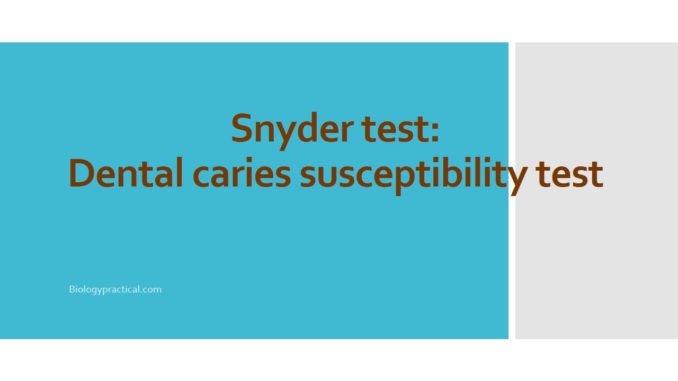
Principle:
- Dental caries (tooth decay) is damage to enamel of tooth that develop into tiny holes or openings caused by bacteria. In course of the formation of dental caries, a variation of microorganisms are known to be involved including Lactobacillus acidophilus, Streptococcus mutans, and Actinomyces odontolyticus. These organisms in the oral flora accounts for production of organic acids, particularly lactic acid, by fermenting carbohydrates that attach to the surface of the teeth. In the prolonged presence of lactic acid, dental enamel goes through decalcification and softening, which leads to the formation of tiny perforations termed as dental caries.
- The actual method of action of these organisms is still not vivid. However, it has been considered that S. mutans excretes an enzyme called dextransucrase (glycosyl transferase), which has ability to polymerizing sucroses into a large polymer, dextran, plus the monosaccharide fructose. This polysaccharide grasp persistently to the teeth and results dental plaque, in which streptococci live in and ferment fructose with the formation of lactic acid.
- Similarly, lactic acid is produced by L. acidophilus as a final product of carbohydrate fermentation. Oral lactobacilli can metabolize glucose found in the mouth, producing organic acids that decrease the oral acid concentration to a pH of less than 5. At this pH, decalcification takes place and dental decay initiates.
- Snyder test is one of the best microbiological methods for detecting susceptibility to dental caries. This test calculates the amount of acid produced by the activity of the lactobacilli on glucose. The test uses a differential medium, Snyder agar (pH 4.7), which contains glucose and the pH indicator bromocresol green that gives the medium a green colour. After incubation, Snyder agar cultures containing lactobacilli from the saliva will show glucose fermentation with the production of acid, which lowers the pH to 4.4, the level of acidity at which dental caries form. At this pH the green medium turns yellow. A culture exhibiting a yellow colour within 24 to 48 hours is indicator of the host’s susceptibility to the formation of dental caries. A culture that does not change colour is suggestive of lower susceptibility.
Requirements:
- Cultures: Organisms of the normal oral flora present in saliva.
- Media: Snyder test agar deep tubes.
- Equipment:
- Bunsen burner
- Ice-water bath
- 1-inch square blocks of paraffin
- Sterile 1-ml pipettes
- Mechanical pipetting device
- Sterile test tubes
- Glassware marking pencil.
Procedure :
- Melt two appropriately labelled Snyder agar deep tubes and cool to 45°C.
- Chew one square of paraffin for 3 minutes without swallowing the saliva. As saliva develops, collect it in a sterile test tube.
- Vigorously shake the collected saliva sample and transfer 0.2 ml of saliva with a sterile pipette into one of the Snyder test medium tubes that have been cooled to 45°C.
– Note: Don’t let the pipette touch the sides of the tubes or the agar. - Mix the contents of the tube thoroughly by rolling the tube between the palms of your hands or by tapping it with your finger.
- Rapidly cool the inoculated tube of Snyder agar in an ice-water bath.
- Repeat Steps 3 through 5 to inoculate the second tube.
- Incubate both tubes for 72 hours at 37°C. Observe cultures at 24, 48, and 72 hours.
- Examine the Snyder test cultures daily during the 72-hour incubation period for a change in the colour of the culture medium.
- Use an un-inoculated tube of the medium as a control.
- Record the colour of the cultures in the Lab Report.
Result interpretations:
- The change of colour to yellow is indicative for a positive result.
- No change in colour is suggestive for a negative result.

